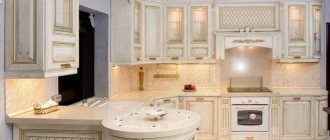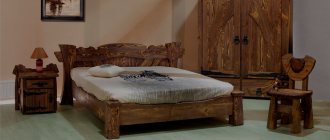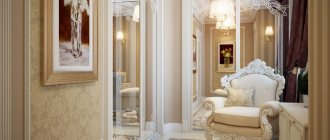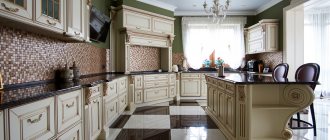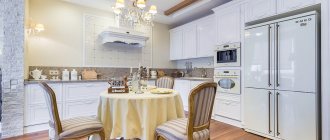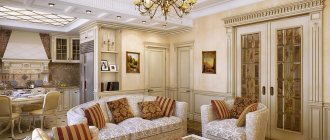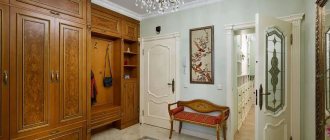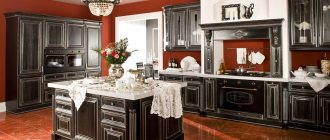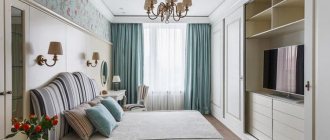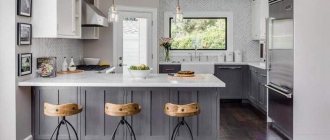Sometimes the influence of time can have a beneficial, rather than destructive, effect on objects. Things turn into antiques and become even more valuable and expensive. Patina, a fashionable and stylish decorative coating that occupies an honorable place in the world of design, can cope with such a task.
Thanks to patina, you can get an extraordinary antique effect, creating a charming atmosphere in any room, including the kitchen. Furniture pieces can become covered with natural patina only after many years of life; such a coating most often appears on copper products.
However, modern decorators have learned to create this amazing coating artificially, using special varnishes, paints and acids. With the help of such means, not only metal objects are aged, but also wooden furniture, as well as other materials.
The patina itself is a greenish tinge that appears on copper over time, under the influence of moisture and air. Patina gradually builds up in layers, making objects more mysterious and similar to museum exhibits.
Patina Features
Patina appears on the surface of various products as a result of the natural process of oxidation. Over time, metal and wooden products can become covered with plaque and cracks, and sometimes a blackening effect appears. Such a set looks like an expensive antique, however, the natural oxidation process can last for decades. That is why people have come up with a lot of ways to artificially age furniture. One of them is covering wood with artificial patina of different colors. To do this, use a combination of various acids, paints and varnishes.
Benefits of a patinated kitchen
- Decorative effect.
Such furniture makes an ordinary classic kitchen more interesting and expensive.
Previously, patina was considered only a film and plaque that appeared on natural wood over time. Today, patina refers to any effect of aged wood. In a hardware store you can now buy special compounds, with the help of which it is not difficult to create something similar with your own hands artificially on MDF facades.
- Practicality.
In such a kitchen, stains are less noticeable.
- Protection.
When making kitchens, furniture manufacturers apply a special composition to the facades, which not only creates the desired patina effect, but also gives the furniture additional protection from moisture. This means that such furniture will last much longer.
Patina on light classic facades is a traditional and elegant combination. Beige or white furniture with a touch of gold or silver is always a win-win option, and it won’t be difficult to match other furnishings.
See also kitchen design ideas with a beige refrigerator.
Pros and cons of patina in the kitchen
The advantages of patination of furniture include the following:
- Durability. The set is less susceptible to wear and tear - varnish applied to the patina in several layers perfectly protects the wood from moisture and other influences.
- Practicality. Furniture with patina looks expensive, but does not require special care. In addition, the antique effect perfectly masks minor scuffs and cracks.
- Availability. Instead of buying a real antique, you can buy a set with a patina, which costs much less, but at the same time looks much like furniture that is decades old.
The disadvantages of applying a patina to the surface of a kitchen unit include the fact that this substance is highly flammable. It is better to equip such an interior with an electric stove rather than a gas one. In addition, it is better to remove decorative candles and candlesticks from the kitchen. The wiring is carefully insulated to prevent fire.
How to quickly make a patina on furniture: step-by-step instructions
Finishing furniture elements with light surfaces with gold leaf will be a worthy decoration, but the main thing is not to overdo it in the amount of gold decor.
Gold leaf goes well with the dark surface of furniture, for example, when it acts as noble abrasions.
The following step-by-step instructions with photographs will tell you how to make a patina on furniture quickly and easily:
- On the face-covered surface of the ends of the stool, as described above, apply a gold leaf with lining paper, previously cut into small longitudinal pieces.
- After waiting for the glued gold leaf to dry completely (the drying time is recommended by the glue manufacturer), walk over the surface with medium or fine-grained sandpaper.
- Rub the surface across the grain or in a circular motion until you achieve the desired abraded effect.
- The end parts are subject to abrasion when using the stool, so be sure to cover them with a protective layer of gold leaf varnish.
Types of patina
Despite the fact that patina is presented on the market in a wide variety, only a few types are the most popular. They are distinguished mainly by shades and decorative effect.
Golden and silver
Gold and silver on a kitchen set is a universal option that matches almost any color of furniture. However, this patina reveals its fullest potential on a white or black surface. The substance also looks impressive on light wood.
Important! Compositions of golden and silver shades are coated with matte varnish, and not glossy, as is customary with other colors.
Contrasting
Contrasting compositions are designed to most effectively highlight carvings and relief areas on furniture. For these purposes, it is recommended to use copper, bronze, gold and silver patina. When self-patination, the substance is first rubbed onto the joints of the frames and panels, after which they move on to the rest of the elements of the set. Then apply another thin layer on top of the main one.
Craquelure
A coating with a craquelure or crackle effect is best suited for kitchens in Provence, country or shabby chic styles. At the same time, the surface of the furniture is characterized by many small cracks - this effect is achieved due to the varnish coating, which cracks as it dries. As a result, the set looks as if it was covered with old paint.
A patina is applied over the cracked layer, which fills all the recesses and gives the kitchen furniture a special decorative effect.
What types of patinas are there for the kitchen?
Patina is a kind of greenish coating that appears on copper products after some time. Its formation is caused by exposure to air and moisture. The peculiarity of patina is that over time, more and more layers of it grow. Thanks to this, the objects acquire the effect of mystery and “museum-like”.
Patina is a special type of decorative coating on furniture that helps to visually age the furniture without losing its aesthetic component.
The kitchen, like any other room in the house, can be furnished not only with comfort, but also with unique charm. Fortunately, modern options for decorating techniques allow you to choose the most suitable one. For those who like to surprise and amaze their acquaintances, and who also emphasize respectability, patinated facades of kitchen furniture are perfect.
Types of patina depending on composition
- Bituminous.
Bituminous varnish is applied to a specific surface. It gets into the recesses and stays there, making them darker than the base.
- Acrylic.
Acrylic paint is mixed with a medium and applied to the surface. Thanks to the variety of colors, this patina can be used to create different design solutions.
Kitchens with patina look very noble and often even more comfortable than some options without it.
- Chemical.
It is applied to a metal base. Oxidant and water paint create a natural aging effect in a few hours.
- Shellac.
With its help, surfaces acquire a light yellow to red-orange hue.
- Wax.
This type is great for textured and cracked surfaces and unprimed wood.
On sets with patina any dirt is much less noticeable.
Types of patina depending on the effect created:
- Gold and silver.
This coating looks especially impressive on white, black and light wood (for example, oak) surfaces. A matte varnish is best suited for coating. With its help, the set will acquire a more gentle and calm look.
Such finishing, as a rule, is carried out at the final stage of decorating the fittings.
- Contrasting (silver, gold, copper, bronze).
This patina looks most impressive on relief facades. It will favorably emphasize every curve of the pattern. It should be thoroughly rubbed into the lower parts of the relief, and then applied to the entire embossing.
To create the effect of antiquity, the facade is rubbed using elements such as sponges of varying hardness, washcloths or even scrapers.
- With the effect of craquelure, crackle.
This coating is used together with a contrasting patina, which is applied to the craquelure varnish after drying. It penetrates perfectly into the cracks that have formed and creates the effect of old paint.
A mandatory procedure is the subsequent application of varnish, which helps to fix the result.
Color palette for a kitchen with patina
The choice of a specific shade for furniture depends on the overall style of the interior. For a kitchen in a classic style, a white set is suitable. Wood and pistachio tones will fit perfectly into a Provence style interior.
White
In a kitchen with white furniture, green, blue and purple patina looks impressive. Gilding or silver composition can add special luxury to a white set. The panels add elegance to the furniture.
Be sure to use details in cream, beige and brown tones with gold. Panels will help make facades more elegant.
The interior of a light kitchen with a patina in a classic style is shown in the photo below.
Black
A black set is a very unusual and bold solution, however, it is not suitable for every interior. It is better not to furnish a small kitchen with such furniture - black color will weigh down the already small space and narrow it. If the kitchen is light and spacious, then you can safely order a black set with patina. For decoration, compositions that imitate silver and gold are best suited. White compositions for covering furniture are also suitable.
Beige
A beige set is usually covered with a patina of the following shades:
- gold;
- grey;
- pale blue;
- green;
- lilac.
This combination looks impressive in a Provence and shabby chic style interior. Golden compositions are suitable for classic kitchen design.
Gray
For a gray kitchen, the best patina is the following tones:
- black;
- blue;
- white;
- green.
Patina effectively enhances the discreet gray color of the furniture and gives it a luxurious look. With proper design, such a set can result in a very beautiful interior design in a classic style. Another advantage of a gray kitchen is the fact that this shade looks equally good in a room of any size.
Green
Green furniture with patina is characteristic of the light shabby chic style. Aged furniture in greenish shades will look no less impressive in country style, especially pistachio and olive colors.
Light tones of green add lightness and airiness to the room. They harmonize well with the patina of the following colors:
- beige;
- grey;
- blue;
- brown.
Advice! Indoor plants against a green background can be somewhat lost in the room.
Red
Red color for a kitchen with patina is a rather bold decision. Such a bright color should be handled extremely carefully so as not to overload the interior with unnecessary decor. Red furniture with an antique effect fits best into country style. In this case, it is advisable to choose not bright colors, but slightly muted ones. For example, a dark burgundy set with a muted bronze or gold patina looks very impressive.
In general, the red color of furniture goes well with the following shades of patina:
- white;
- black;
- grey;
- terracotta;
- beige;
- brown.
There should be a minimum of additional decor in such an interior.
Patina in other styles
The correct combination of facade color and patina was analyzed above, so we will focus on the shade palette of different styles.
- Country.
The facades of such a kitchen can be green, brown, red.
- Provence.
This style is characterized by the following headset colors: beige, gray, brown.
The set may contain carved elements, and the patina, emphasizing their relief, is usually made 1-2 tones darker.
- Shabby chic.
Characteristic shades of this style: green, white, beige.
If you love vintage style in furniture and want to bring a sense of antiquity to your kitchen, feel free to choose a set decorated with patina. It will become not only functional, but also a full-fledged aesthetic element. Believe me, your friends will not be able to help but appreciate its luxurious appearance.
In this way, you can bring additional creativity to the interior of your kitchen space, as well as improve its level of comfort and aesthetics.
Finishing the floor, walls and ceiling in the kitchen with patina
If the furniture is covered with patina, it is necessary to highlight it due to the surrounding environment. In particular, this effect can be achieved with the help of discreet colors of the walls, floor and ceiling.
A kitchen with a patina in the Provence style is usually covered with wallpaper with a rough texture. The interior, designed in a classic direction, involves a combination of basic colors of the environment with neutral tones.
The kitchen ceiling with a patinated set is usually white, which visually expands the space and does not overload it. In general, the ceiling covering should be a couple of shades lighter than the walls and floor.
The apron (the area that separates the wall cabinets from the work surface) is usually covered with washable wallpaper or covered with ceramic tiles. Alternatively, you can decorate this area with stone or its imitation.
Important! Under no circumstances should you make a plastic apron in the kitchen with a patina. Plastic deprives the classic style of elegance, and Provence - naturalness.
Some secrets of handling white color
Now a little instruction on how to use light colors in the interior.
- To prevent the room from seeming cold, the fronts of the furniture can be made light cream. This is especially true if the kitchen windows face north. In this case, the cream room will look white, but more cozy and warm.
- Snow-white furniture can look monotonous. To avoid this, order not smooth facades, but patterned, embossed ones with frames.
- If the kitchen has white furniture and the same walls, they visually merge with each other and interior items cease to be a decoration of the room. This optical effect can be eliminated by choosing colored fronts for the lower cabinets and cabinets, and white for the upper ones. The lower level will not merge with the walls, while the upper level will seem to dissolve and will not overload the space.
A combination of light and dark tones in a patinated kitchen.
- The second method to get rid of monotony is to combine furniture surfaces of different colors. By diluting the whiteness, you will emphasize it. For example, you can choose black, dark brown or dark gray countertops made of natural stone or imitation stone and white facades.
- As the video shows, you can combine white with other colors. At the same time, a variety of options can be successful. For example, black and white kitchen spaces are popular. To make such a room more comfortable, it is advisable to add another tone - in accessories, textiles, utensils, and an apron in the work area. Or choose a third shade for the walls. You can dilute the combination of black and white with orange, red, beige, and pearl.
Read also the article “Classic white kitchen never goes out of style.”
You can correct the situation of monotony by adding small details of a different color. For example, a white kitchen with a silver patina will retain its main color, but it will be diluted and the room will not be cold.
Did you like the article? Subscribe to our Yandex.Zen channel
Great article 0
Tables and chairs for the kitchen with patina
A kitchen set with a patina looks great together with chairs and tables, which also have an antique effect. Furniture with decorative carvings, the motifs of which echo the decor of the set itself, is also suitable.
Advice! For a kitchen in the Provence style, you can purchase wicker chairs, which will only enhance the notes of this trend.
Kitchen appliances
Furniture with patina does not fit well in appearance with modern household appliances, so all equipment is usually hidden behind facades.
The refrigerator and stove should match the tone with other interior elements. For example, you can install white appliances in an interior with light walls and furniture. In a kitchen with a lot of red, green or black, metallic will look better.
Selection of decor and accessories
The selection of interior decorations largely depends on the style in which the kitchen is designed. The classic direction automatically excludes the abundance of additional decor - in such an interior, the patina itself, expressive lampshades and carvings on the kitchen set act as decoration. You can dilute pastel colors with the help of green accents - indoor plants. In addition, bright textiles look impressive in a bright kitchen with patina: curtains, upholstery, napkins, etc.
If the kitchen set has discreet shades, almost any upholstery color will suit it. In a kitchen where there is a lot of green or red, it is better to use curtains of the same shades; light colors are also suitable. The latter option goes well with almost any color of furniture.
Advice! The interior of a Provence style kitchen can be decorated with pastel-colored fabrics with simple patterns. Curtains whose color matches the color of the patina look impressive in such an interior.
Lighting rules
A kitchen with antique-style furniture does not tolerate poor lighting. The lack of light makes the interior faded and largely reduces the decorative effect of the patina to nothing. The room should have at least two light sources, while chandeliers and lamps of luxurious shapes will fit well. This design will perfectly complement the classic style, which is replete with white tones.
Interior styles for kitchens with patina
Patina gives furniture an antique look, the illusion that it is many years old. Consequently, arranging a kitchen in modern styles, for example, high-tech, automatically excludes patination of the set. This effect looks good in the interior of the following areas:
- Provence;
- retro;
- classic;
- shabby chic;
- country.
Depending on the interior in which patina is used, preference is given to different colors.
Classic
Classic-style kitchens are distinguished by an abundance of white and its variations: beige and cream shades. This interior design allows you to visually expand the space, which is especially important for decorating a small kitchen.
In addition, the classic style includes the following characteristics:
- interior design involves the use of natural materials;
- the color scheme is restrained, even accents should not be too bright and colorful;
- furniture can be either laconic and strict in form, or, conversely, have a rather elaborate decor;
- Kitchen wall cabinets should ideally reach the ceiling;
- glass cabinet doors should be frosted so that only the general outlines of the dishes can be seen;
- electrical appliances must be built into the furniture.
A classic-style kitchen is best combined with a patina in neutral tones - gray, greenish, bronze. Gold and silver patina is the most luxurious option, however, these colors should not be overused. Such furniture will look tasteless in a kitchen that is replete with additional decor: paintings in carved frames, candles, figurines, painted dishes, patterned wallpaper, etc.
Advice! Bronze fittings will fit perfectly into the interior of a classic kitchen with white furniture: faucet, appliances, chandelier, etc.
Provence
The Provence style kitchen is characterized by the following features:
- the furniture has soft, rounded lines;
- preferred furniture color – white, cream, creamy, sand, champagne, pistachio, light blue, light yellow;
- the classic version of the Provence style involves the use of oak furniture, however, now this direction is more democratic;
- The facade of furniture is often decorated with wickerwork and latticework.
The patina of yellow and brown shades goes best with a Provence style kitchen. Furniture covered with gold patina looks no less impressive in such an interior. Patination with a craquelure effect is very popular when decorating a kitchen in the Provence style. Many small cracks look very impressive in combination with soft tones and lines, creating an atmosphere of comfort and warmth. At the same time, craquelure gives the kitchen set sophistication and high cost.
Advice! Notes of Provence can be enhanced with painted ceramic handles on the kitchen set.
How to complement a kitchen set with patina
The correct choice of decorative elements contributes to a holistic perception of the entire interior. This also applies to kitchens that have succumbed to mechanical aging. Patina itself is part of the decor. Therefore, all its other elements must be in harmony with it.
Curtains
Their shade depends on the color scheme of the furniture. For a kitchen with neutral tones, almost any shade of curtains is suitable. Brighter and richer curtains go best with white furniture.
Wallpaper
Patina will look best on a subdued, neutral tone.
It is also possible to use wallpaper with simple patterns and different textures.
Ceiling
The most universal and harmonious color is white. It will visually increase the space and improve the perception of decorated furniture. The main principle is that the ceiling should be lighter than the entire set.
Floor
Its texture and color should match the style and tone of the entire kitchen.
It is important to know which concepts this furniture print combines best with.
Apron
This part of the kitchen should be made from a material that is easy to clean. It is best to choose an apron of the same color as the patina.
Table, chairs
These pieces of furniture must be wooden and also aged in the same way as the entire set.
The classic design is one of the most suitable.
Technique
It shouldn't be too modern. Antique-style models with interesting facades are perfect.
Lighting
A dark or classic kitchen in light colors with a patina should be filled with light. It will help create an additional effect and emphasize the advantages of aged furniture.
It is necessary to place the number of lamps that will cope with this task.
DIY patina in the kitchen interior
The safest thing to do would be to give the furniture for patination to a specialist or order a kitchen set already with patina, however, if you wish, you can apply it yourself - giving the kitchen an antique effect is not so difficult if you strictly follow all the instructions.
Patina is applied to the surface of the headset according to the following scheme:
- First, the solid wood façade is tinted or painted. Furniture made from MDF is pre-coated with enamel, veneer or PVC film.
- After this, a transparent primer is applied to the facade.
- As soon as the soil dries, it is sanded.
- After this, the kitchen set is covered directly with patina.
- The next stage is grouting. The facade must be wiped with a special scraper, a hard sponge or even a steel wool.
- The process is completed by applying varnish. It can be either matte or glossy. Typically, polyurethane varnish is chosen for patination - it effectively protects the wood in the kitchen from moisture. The varnish is applied in several layers, usually 2-3.
Important! The antique effect increases depending on how intense the sanding was.
The patination process is described in more detail in the video below:
Kitchen design ideas with patina
Furniture covered with patina will fit perfectly into a room with a different design style. Below are examples of interior design that can serve as a great source of inspiration.
